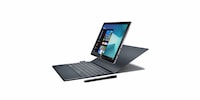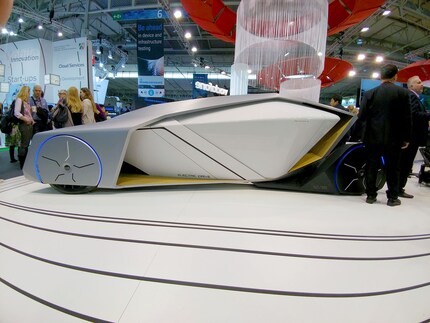
News + Trends
Samsung at MWC - all guns blazing on fibre optics, 5G and the Internet of Things
by Dominik Bärlocher

The Mobile World Congress MWC in Barcelona is over. In addition to flagships and surprises on the smartphone market, we took a look into the future. Here are some speculative answers to the question "What's coming in a year's time?"
Thinner, lighter, faster seems to be over when we look at the stands at the Mobile World Congress 2017 in Barcelona. The trend is moving away from ultra-light, ultra-fast flagships and towards devices that are focussed on a specific customer segment. In a conversation in the queue at MWC, we took stock. Where is the technology industry heading? What is coming? What do we hope for?
The implications, among others:
I'm sure that with the last point alone you have about a dozen use cases that I'm not listing here. Because I have them. But think about it: 5G in your pocket means that all the computing power you used to have to carry around with you can be somewhere. All you really need is a 5G device and a screen. Because with just a few milliseconds of latency, you can even live with it when gaming.
In economic terms, however, this means that the pressure on mobile phone providers will be great. Arguments such as "We'll have a 5G network in five years" will no longer be valid after the launch of these devices. Because 5G will not simply be an upgrade. 5G will herald a new technological era.
The big brands in the smartphone business are continuing to pursue the trend of thinner, faster, lighter smartphones. But they will also place more importance on another form factor: haptics. Smartphones have levelled off in terms of size between four and six inches diagonally and the shape of the rectangle with rounded corners is not only the most efficient but also the established shape of a smartphone. But customers want one-handed operation back.
LG is taking a first step in the direction of the large smartphone with easier operation with the G6. The smartphone has an 18:9 aspect ratio, which makes the screen slimmer and the phone easier to handle. In terms of hardware, the screen format also gives manufacturers enough space to install the phone's intelligence and a powerful battery under the screen.
We expect other manufacturers to pick up on this trend and the screen format will catch on.
In the past few days, we have thrown smartphones into the water, dropped steel balls on them, scratched the screen with a cutter knife and hit it with a hammer. In between, we threw devices into the water and then threw them across the room "to dry". The phones still worked afterwards, which is quite good because otherwise we would probably have got into trouble with the manufacturers.
I can tell you one thing: it feels good to do violence to a smartphone. For years, we have taken care of these fragile devices. Not a drop of water should get on it. Every time the device falls, it's a moment of shock. Is the expensive device ruined? Do I need a replacement? No more of that! And that's a very, very good thing.
This now seems to be a thing of the past. It's not just flagship brands that rely on IP 68 certification. Devices are becoming more robust and water-resistant, making our everyday lives more carefree.
Software-wise, we've seen Android versions for kids, security freaks, photo buffs and social media fanatics.
In short, the word "all-purpose" seems to be a thing of the past. Android as an open platform is becoming more flexible than ever. Experts are familiar with this from the Linux operating system, where there are x distributions with very specific use cases.
All these devices talk to a smartphone that accompanies the user in everyday life. We have not found a device that does not rely on Bluetooth as a communication technology.
The trend away from products for the masses is also recognisable here. Smartwatches are now available especially for children, the water bottles should appeal to iPhone fans, at least in terms of design, and we didn't recognise at first glance who would like blinking eyes on power banks. But these people now have something that is made for them.
At the launch of the iPhone 7 and iPhone 7 Plus, Apple abolished the 3.5 mm headphone jack. I and other observers on the scene expected this to herald a trend that would lead to the abolition of the long-established connector. We were wrong.
It's obvious that there's enough room for the jack in larger devices like the LG G6, but smaller phones also retain the jack. For comparison: The new iPhone is 7.1mm thick. The new Oppo R9s is 6.5mm thick and still has a headphone jack.
In short, the industry seems to be signalling to Apple "No, you're no longer the pioneer. We're no longer copying you".
However, the influence of the Apple company on the entire industry is visibly diminishing.
Journalist. Author. Hacker. A storyteller searching for boundaries, secrets and taboos – putting the world to paper. Not because I can but because I can’t not.
Interesting facts about products, behind-the-scenes looks at manufacturers and deep-dives on interesting people.
Show allThe most important press conference at the MWC was probably that of the South Korean company Samsung. Smartphone fans wanted to see the Samsung Galaxy S8, but Samsung won't be unveiling its new flagship until 29 March. However, in addition to the tablet, the company has made a strong announcement that will have implications far beyond the devices in your pocket. The announcement that Samsung is producing devices that will bring 5G from the internet backbone to the home router wirelessly at gigabit speeds should cause far more of a stir than a new phone.
The trend so far has been to create a smartphone for everyone. At MWC, we saw the first trends towards specifying hardware beyond prototypes and concept ideas. The CAT s60 is no longer the only device that is shockproof or includes an infrared camera. We have seen devices that are designed for children's hands. Devices that can work for a long time without a battery charge but are not as powerful. Smartphones whose camera can be turned round, making the selfie cam superfluous. Hard-wired torches that do not rely on the flash of the main camera being switched on.
The smartphone is no longer just used as a means of communication for people. Everything is becoming smart. All kinds of smart devices are on sale at stands. Cameras that can be inserted into body orifices for health checks and provide images from inside the user's body. Blood pressure, heart rate and stress sensors. Door opening mechanisms that can unlock any door lock via Bluetooth to which a corresponding mechanism is attached. The flipside of the Bluetooth door lock: closed-source crypto from China. Haha. Funny. Smart water bottles whose smart application is a mystery to us.

The big manufacturers, above all Samsung, are expanding their ecosystems. The gap between Android devices and smartphones will be closed. After all, who hasn't been annoyed by the fact that the tablet synchronises all apps and a lot of app data, but not the text messages from the mobile? Total frustration, isn't it? The gap between the devices is closed and all devices talk to all devices. This probably also means that the SIM card as a physical object is slowly having to think about giving up.
Everyone should communicate with everything and with everyone. Without latency and complicated fuss. It will be the big companies such as Samsung, Apple and Google that will make their ecosystems suitable for the masses first. Not because they are necessarily the best manufacturers of products in the Internet of Things (IoT), but because they have the capacity and financial means to create and support a complete ecosystem. Smaller IoT companies can produce better devices, but these are just individual items and not part of an entire concept.
Every smartphone, regardless of price range and manufacturer, had a headphone jack at the Mobile World Congress. From low-cost providers from Shenzhen, China, to inexpensive phones such as the new Lenovo Motos and the Wiko Wim, to flagships such as the Huawei P10 or the new Sony Xperias, they all have the connector installed. Only HTC is joining in, but is working on greatly improved software that should bring the sound to your ears in the tried and tested quality or better.
Other economic reasons could be that there is competition in the Android market. Apple's business model stipulates that only they manufacture devices with the iOS mobile operating system, no one else. So if you want iOS, you buy Apple. It's a different story with Android. The choice is huge and the question of whether to go for a rugged design or a slim flagship is just as legitimate as the question of the headphone jack. Android manufacturers therefore run the risk that customers will go to the competition if they leave out any of the features. But that doesn't mean that Apple has to grovel and the iPhone 8 urgently needs a jack again. Apple doesn't need anything because they have no competitors in their market niche.